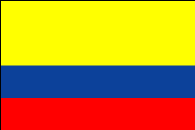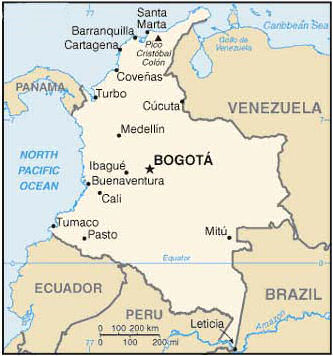Table of Contents
| Location and Size | Credit and Collections |
| Government | Risk Assessment |
| Legal System | Business Climate |
| People | Business Protocol |
| Economy | |
| Comparative Indicators |
12345
Location and Size
Colombia is located in Northern South America. It is bordered by the Caribbean Sea and Panama to the north, the North Pacific Ocean to the west, Venezuela and Brazil to the east, and Peru and Ecuador to the South.
Bogota, its capital is in the central part of the country, which covers an area of 1,138,910 sq. km, slightly less than twice the size of Texas.
Government
Colombia’s government is a presidential republic comprised of 32 departments and one capital district.
Branches:
- Executive: Chief of State and Head of Government – President Gustavo Francisco PETRO Urrego (since 7 August 2022); Vice President Francia Elena MARQUEZ Mina; cabinet appointed by the president
- Legislative: bicameral Congress consists of the Senate (108 seats; members elected by popular vote to serve four-year terms) and the Chamber of Representatives (188 seats; members elected by popular vote to serve four-year terms)
- Judicial: four roughly coequal, supreme judicial organs: Supreme Court of Justice; Council of State; Constitutional Court; Superior Judiciary Council.
Legal System
Colombia has a civil law legal system influenced by the Spanish and French civil codes.
The country has not accepted compulsory International Court of Justice (ICJ) jurisdiction. It does, however, accept International Criminal Court (ICCt) jurisdiction.
People
- Population: 49,059,221 (2022 est.)
- Population growth rate: .75% (2022)
- Languages: Spanish (official) and 65 Amerindian languages
- Literacy: 94.2% (2022 est.)
- Ethnic Make-up: Mestizo and White 87.6%, Afro-Colombian (includes Mulatto, Raizal, and Palenquero) 6.8%, Amerindian 4.3%, unspecified 1.4% (2022 est.)
- Religions: Christian 92.3% (predominantly Roman Catholic), other 1%, unspecified 6.7% (2022 est.)
Economy
The Republic of Colombia has the fourth largest economy in Latin America, after Brazil, Mexico, and Argentina, and the third largest population with approximately 51.5 million inhabitants. Colombia is a country of micro and small businesses. According to the Ministry of Labor, these businesses represent more than 90 percent of the national productive sector and 80 percent of employment. Colombia also has a relatively open business environment, ranking 67th out of 190 economies for overall ease of doing business in the World Bank’s most Doing Business study for 2020.
Colombia’s gross domestic product (GDP) totaled USD 314.4 billion in 2021 according to the Economist Intelligence Unit (EIU). Economic growth has recovered robustly from the pandemic, with growth of 10% in 2021 and 5% projected for 2022.
For Colombia’s trade worldwide, the EIU estimated that merchandise exports from Colombia amounted to USD 42.7 billion in 2021, a rebound from USD 32.3 billion in 2020. Merchandise imports totaled USD 56.7 billion in 2021, compared with imports of USD 41.2 billion in 2020.
U.S.-Colombia trade was negatively impacted by the COVID pandemic in 2020, but rebounded dramatically in 2021 and the first half of 2022. In 2021, U.S. exports to Colombia were USD 16.7 billion and Colombian exports to the United States were USD 13.2 billion, with a trade balance slightly more favorable to the United States than prior to the COVID-19 pandemic.
Leading Markets (2022): US 31%, China 11%, Panama 6%, Ecuador 5%
Leading Exports – Commodities: crude petroleum, coal, refined petroleum, coffee, gold
Leading Suppliers (2022): US 27%, China 20%, Mexico 7%, Brazil 6%
Leading Imports – Commodities: refined petroleum, cars, broadcasting equipment, packaged medicines, corn
Top Industries: textiles, food processing, oil, clothing and footwear, beverages, chemicals, cement; gold, coal, emeralds
Top Agricultural Products: sugar cane, milk, oil palm fruit, potatoes, rice, bananas, cassava leaves, plantains, poultry, maize
Comparative Economic Indicators – 2023
| Colombia | Brazil | Ecuador | Panama | Peru | Venezuela | |
| Population (millions) | 50.9 | 212.6 | 17.6 | 4.3 | 33.0 | 28.4 |
| Population growth rate (%) | 1.1 | 0.5 | 1.2 | 1.3 | 1.2 | -1.0 |
| Age Structure (%) (15 to 64 years old) |
68.72 | 69.61 | 65.01 | 65.03 | 65.35 | 63.49 |
| Age Structure (%) (65+ years old) |
9.39 | 9.94 | 7.82 | 8.57 | 8.32 | 8.34 |
| Literacy (%) | 95.6 | 93.2 | 93.6 | 95.7 | 94.5 | 97.1 |
| Unemployment rate (%) | 14.34 | 14.4 | 6.43 | 12.09 | 4.83 | 6.41 |
| Inflation (%) | 3.5 | 8.3 | 0.13 | 1.63 | 4.27 | 146,101.7 |
| Population below poverty line (%) (estimates) | 35.7 | 4.2 (2022) |
25 (2022) |
22.1 (2022) |
20.2 (2022) |
33.1 (2022) |
| GDP** (USD billions) | 754.6 | 3128 | 189.9 | 126.4 | 421.9 | 269.1 |
| GDP real growth rate (%) | 10.7 | 4.6 | 4.2 | 15.3 | 13.4 | 19.7 |
| GDP per capita** (USD) | 14,600.0 | 14,600.0 | 10,700.0 | 29,000.0 | 12,500.0 | 7,704.0 |
| Public debt (% of GDP) | 90.4 | 100.6 | 45.4 | 37.8 | 34.7 | 38.9 |
| Industrial production growth rate (%) (estimates) | 9.7 | 4.5 (2021) |
0.5 (2021) |
37.5 (2021) |
16.4 (2021) |
-2.0 (2021) |
| Exports (USD billions) | 50.8 | 317.2 | 29.3 | 27.2 | 66.1 | 83.4 |
| Imports (USD billions) | 70.8 | 297.9 | 28.6 | 24.6 | 58.6 | 18.4 |
| Reserves of foreign exchange and gold (USD billions) | 58.0 | 362.2 | 7.9 | 9.6 | 74.8 | 9.8 |
| Currency | Peso COP |
Real BRL |
USD | Balboa PAB |
Nuevo Sol PEN |
Bolivar Fuerte VBF |
| Exchange rates (per USD) 02/13/2023 | 4,874.7 | 5.2 | 1.0 | 1.0 | 3.9 | 2,428,734.3 |
| Exchange rates (per EUR) 02/13/2023 | 5,204.3 | 5.6 | 1.1 | 1.1 | 4.1 | 2,593,289.2 |
Economic Data from CIA World Factbook
Credit and Collections
Collecting in Colombia
Colombian Statues of Limitations:
- Open Account: 3 years
- Promissory Note: 3 years
- Written Contracts: 3 years
- Oral Agreements: n/a
Risk Assessment
Coface Country Rating: A4 — A somewhat shaky political and economic outlook and a relatively volatile business environment can affect corporate payment behavior. Corporate default probability is still acceptable on average.
Coface Business Climate Rating: A4 — see above
Economic growth will cool sharply in 2023 owing to a high base of comparison, and as inflation remains elevated and credit conditions further tighten (from 1.75% up to September 2021 to 12% in December 2022). This situation will also dent household consumption (71% of GDP), implying a lower expansion rate, albeit the roughly 3% real increase in the minimum wage.
Business Climate
Colombia’s government has actively encouraged foreign direct investment with the initiation of economic liberalization reforms. These reforms provided for national treatment of foreign investors, lifted controls on remittance of profits and capital, and allowed foreign investment in most sectors. The current administration has continued efforts to open up the economy. Progress in this regard is particularly evident in the area of telecommunications, accounting/auditing, energy, mining, and tourism, and to a lesser extent in legal services, insurance, distribution services, advertising, and data processing.
Colombia has a comprehensive legal framework for business. Its judicial system defines the legal rights of commercial entities, reviews regulatory enforcement procedures, and adjudicates contract disputes in the business community. The judicial process, however, is hampered by time-consuming bureaucratic requirements and corruption.
Economic Freedom: Colombia’s economic freedom score is 65.1, making its economy the 60th freest in the 2022 Index. Colombia is ranked 12th among 32 countries in the Americas region, and its overall score is above the regional and world averages.
Market Access: The US-Colombia Free Trade Agreement (FTA) was ratified by the US Congress in October 2011 and implemented in 2012. Colombia has signed or is negotiating FTAs with a number of other countries, including Canada, Chile, Mexico, Switzerland, the EU, Venezuela, South Korea, Turkey, Japan, and Israel. The Colombian government has also instituted a number of drawback and duty deferral programs, such as the creation of Free Trade Zones, in order to attract foreign investment and promote the importation of capital goods.
Regulatory System: Colombian legal and regulatory systems are generally transparent and consistent with international norms. The commercial code and other laws cover such broad areas as banking and credit, bankruptcy/reorganization, business establishment/conduct, commercial contracts, credit, corporate organization, fiduciary obligations, insurance, industrial property, and real property law. The civil code contains provisions relating to contracts, mortgages, liens, notary functions, and registries. Enforcement mechanisms exist, but historically the judicial system has not taken an active role in adjudicating commercial cases.
Business Protocol
- Most Colombians have both a maternal and paternal surname and will use both. The father’s surname is listed first and is the one used in conversation.
- Always refer to people by the appropriate honorific title and their surname.
- Relationship building is crucial. Engaging in small talk before and after meetings is vital towards building a sense of trust and goodwill.
**********
Subscribe to the Credit-to-Cash Advisor
Monthly e-Newsletter — It’s Free
This information is provided by ABC-Amega Inc. Providing international receivable management and debt collection services for exporters to more than 200 countries. For further information, contact [email protected].

